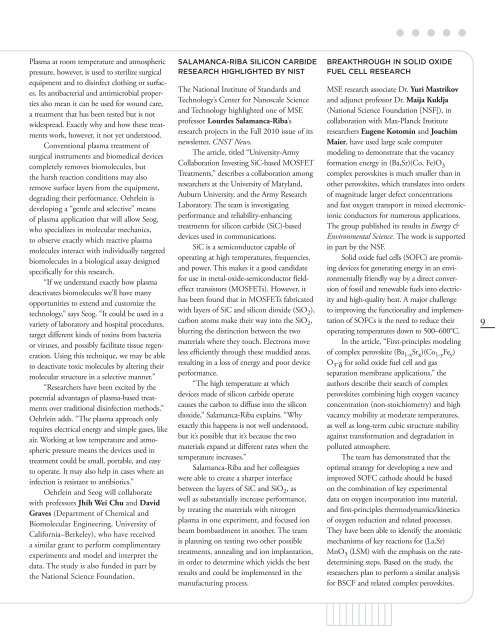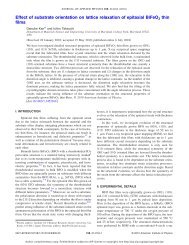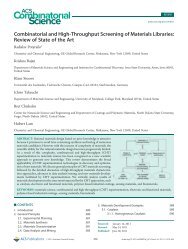Spring 2011 - Materials Science and Engineering - University of ...
Spring 2011 - Materials Science and Engineering - University of ...
Spring 2011 - Materials Science and Engineering - University of ...
You also want an ePaper? Increase the reach of your titles
YUMPU automatically turns print PDFs into web optimized ePapers that Google loves.
Plasma at room temperature <strong>and</strong> atmospheric<br />
pressure, however, is used to sterilize surgical<br />
equipment <strong>and</strong> to disinfect clothing or surfaces.<br />
Its antibacterial <strong>and</strong> antimicrobial properties<br />
also mean it can be used for wound care,<br />
a treatment that has been tested but is not<br />
widespread. Exactly why <strong>and</strong> how these treatments<br />
work, however, it not yet understood.<br />
Conventional plasma treatment <strong>of</strong><br />
surgical instruments <strong>and</strong> biomedical devices<br />
completely removes biomolecules, but<br />
the harsh reaction conditions may also<br />
remove surface layers from the equipment,<br />
degrading their performance. Oehrlein is<br />
developing a “gentle <strong>and</strong> selective” means<br />
<strong>of</strong> plasma application that will allow Seog,<br />
who specializes in molecular mechanics,<br />
to observe exactly which reactive plasma<br />
molecules interact with individually targeted<br />
biomolecules in a biological assay designed<br />
specifically for this research.<br />
“If we underst<strong>and</strong> exactly how plasma<br />
deactivates biomolecules we’ll have many<br />
opportunities to extend <strong>and</strong> customize the<br />
technology,” says Seog. “It could be used in a<br />
variety <strong>of</strong> laboratory <strong>and</strong> hospital procedures,<br />
target different kinds <strong>of</strong> toxins from bacteria<br />
or viruses, <strong>and</strong> possibly facilitate tissue regeneration.<br />
Using this technique, we may be able<br />
to deactivate toxic molecules by altering their<br />
molecular structure in a selective manner.”<br />
“Researchers have been excited by the<br />
potential advantages <strong>of</strong> plasma-based treatments<br />
over traditional disinfection methods.”<br />
Oehrlein adds. “The plasma approach only<br />
requires electrical energy <strong>and</strong> simple gases, like<br />
air. Working at low temperature <strong>and</strong> atmospheric<br />
pressure means the devices used in<br />
treatment could be small, portable, <strong>and</strong> easy<br />
to operate. It may also help in cases where an<br />
infection is resistant to antibiotics.”<br />
Oehrlein <strong>and</strong> Seog will collaborate<br />
with pr<strong>of</strong>essors Jhih Wei Chu <strong>and</strong> David<br />
Graves (Department <strong>of</strong> Chemical <strong>and</strong><br />
Biomolecular <strong>Engineering</strong>, <strong>University</strong> <strong>of</strong><br />
California–Berkeley), who have received<br />
a similar grant to perform complimentary<br />
experiments <strong>and</strong> model <strong>and</strong> interpret the<br />
data. The study is also funded in part by<br />
the National <strong>Science</strong> Foundation.<br />
Salamanca-Riba Silicon Carbide<br />
Research Highlighted by NIST<br />
The National Institute <strong>of</strong> St<strong>and</strong>ards <strong>and</strong><br />
Technology’s Center for Nanoscale <strong>Science</strong><br />
<strong>and</strong> Technology highlighted one <strong>of</strong> MSE<br />
pr<strong>of</strong>essor Lourdes Salamanca-Riba’s<br />
research projects in the Fall 2010 issue <strong>of</strong> its<br />
newsletter, CNST News.<br />
The article, titled “<strong>University</strong>-Army<br />
Collaboration Investing SiC-based MOSFET<br />
Treatments,” describes a collaboration among<br />
researchers at the <strong>University</strong> <strong>of</strong> Maryl<strong>and</strong>,<br />
Auburn <strong>University</strong>, <strong>and</strong> the Army Research<br />
Laboratory. The team is investigating<br />
performance <strong>and</strong> reliability-enhancing<br />
treatments for silicon carbide (SiC)-based<br />
devices used in communications.<br />
SiC is a semiconductor capable <strong>of</strong><br />
operating at high temperatures, frequencies,<br />
<strong>and</strong> power. This makes it a good c<strong>and</strong>idate<br />
for use in metal-oxide-semiconductor fieldeffect<br />
transistors (MOSFETs). However, it<br />
has been found that in MOSFETs fabricated<br />
with layers <strong>of</strong> SiC <strong>and</strong> silicon dioxide (SiO 2 ),<br />
carbon atoms make their way into the SiO 2 ,<br />
blurring the distinction between the two<br />
materials where they touch. Electrons move<br />
less efficiently through these muddied areas,<br />
resulting in a loss <strong>of</strong> energy <strong>and</strong> poor device<br />
performance.<br />
“The high temperature at which<br />
devices made <strong>of</strong> silicon carbide operate<br />
causes the carbon to diffuse into the silicon<br />
dioxide,” Salamanca-Riba explains. “Why<br />
exactly this happens is not well understood,<br />
but it’s possible that it’s because the two<br />
materials exp<strong>and</strong> at different rates when the<br />
temperature increases.”<br />
Salamanca-Riba <strong>and</strong> her colleagues<br />
were able to create a sharper interface<br />
between the layers <strong>of</strong> SiC <strong>and</strong> SiO 2 , as<br />
well as substantially increase performance,<br />
by treating the materials with nitrogen<br />
plasma in one experiment, <strong>and</strong> focused ion<br />
beam bombardment in another. The team<br />
is planning on testing two other possible<br />
treatments, annealing <strong>and</strong> ion implantation,<br />
in order to determine which yields the best<br />
results <strong>and</strong> could be implemented in the<br />
manufacturing process.<br />
Breakthrough in Solid Oxide<br />
Fuel Cell Research<br />
MSE research associate Dr. Yuri Mastrikov<br />
<strong>and</strong> adjunct pr<strong>of</strong>essor Dr. Maija Kuklja<br />
(National <strong>Science</strong> Foundation [NSF]), in<br />
collaboration with Max-Planck Institute<br />
researchers Eugene Kotomin <strong>and</strong> Joachim<br />
Maier, have used large scale computer<br />
modeling to demonstrate that the vacancy<br />
formation energy in (Ba,Sr)(Co, Fe)O 3<br />
complex perovskites is much smaller than in<br />
other perovskites, which translates into orders<br />
<strong>of</strong> magnitude larger defect concentrations<br />
<strong>and</strong> fast oxygen transport in mixed electronicionic<br />
conductors for numerous applications.<br />
The group published its results in Energy &<br />
Environmental <strong>Science</strong>. The work is supported<br />
in part by the NSF.<br />
Solid oxide fuel cells (SOFC) are promising<br />
devices for generating energy in an environmentally<br />
friendly way by a direct conversion<br />
<strong>of</strong> fossil <strong>and</strong> renewable fuels into electricity<br />
<strong>and</strong> high-quality heat. A major challenge<br />
to improving the functionality <strong>and</strong> implementation<br />
<strong>of</strong> SOFCs is the need to reduce their<br />
operating temperatures down to 500–600°C.<br />
In the article, “First-principles modeling<br />
<strong>of</strong> complex perovskite (Ba 1-x Sr x )(Co 1-y Fe y )<br />
O 3 - d for solid oxide fuel cell <strong>and</strong> gas<br />
separation membrane applications,” the<br />
authors describe their search <strong>of</strong> complex<br />
perovskites combining high oxygen vacancy<br />
concentration (non-stoichiometry) <strong>and</strong> high<br />
vacancy mobility at moderate temperatures,<br />
as well as long-term cubic structure stability<br />
against transformation <strong>and</strong> degradation in<br />
polluted atmosphere.<br />
The team has demonstrated that the<br />
optimal strategy for developing a new <strong>and</strong><br />
improved SOFC cathode should be based<br />
on the combination <strong>of</strong> key experimental<br />
data on oxygen incorporation into material,<br />
<strong>and</strong> first-principles thermodynamics/kinetics<br />
<strong>of</strong> oxygen reduction <strong>and</strong> related processes.<br />
They have been able to identify the atomistic<br />
mechanisms <strong>of</strong> key reactions for (La,Sr)<br />
MnO 3 (LSM) with the emphasis on the ratedetermining<br />
steps. Based on the study, the<br />
researchers plan to perform a similar analysis<br />
for BSCF <strong>and</strong> related complex perovskites.<br />
9












